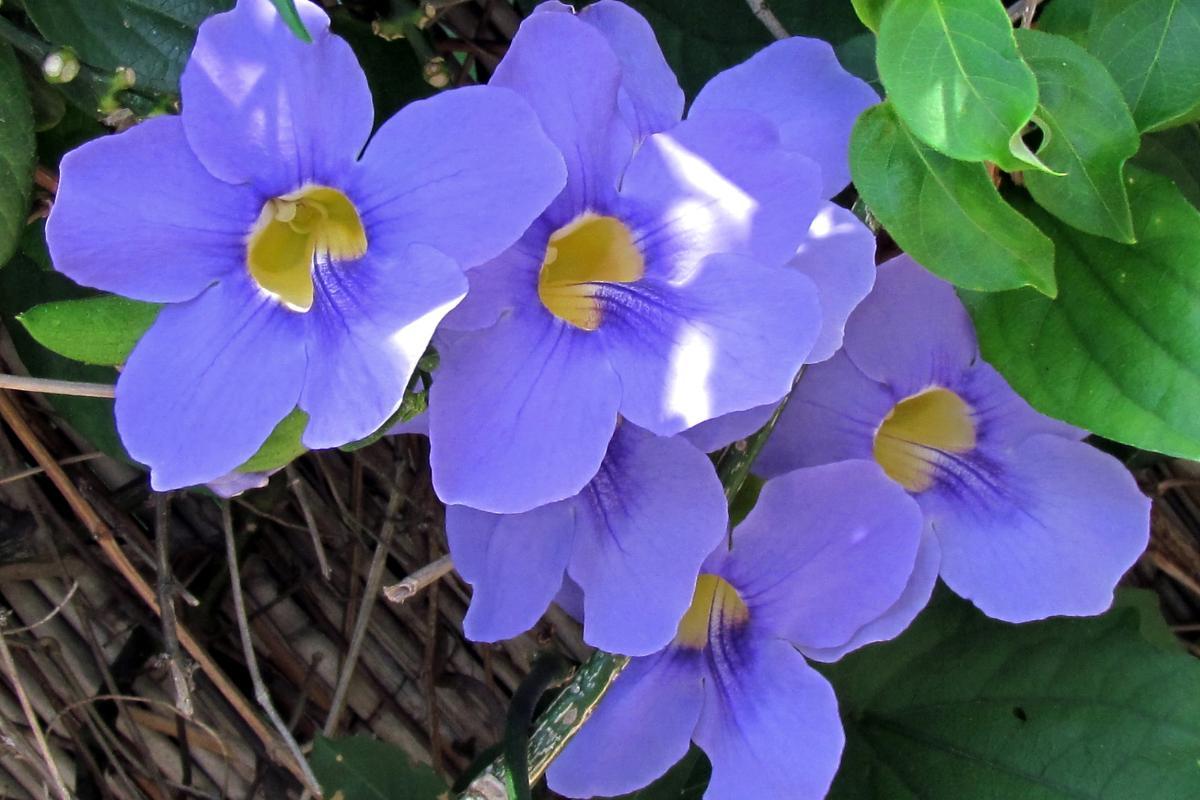Thunbergia Grandiflora Care and Propagation


Thunbergia grandiflora is a flowering plant with many common names, including the trumpet vine, blue thunbergia and the Bengal clockvine, among others. As these common names suggest, Thunbergia grandiflora is a vine, i.e. a plant with parts that trail or climb onto other surfaces. The blooms of the trumpet vine are blue or purplish, the reason for some of their common names. It is native to various parts of Asia, but is often associated with India. It reproduces by cuttings or seeds, but there are also many hybrids and cultivars of this plant. Learn more with thedailyECO as we explain Thunbergia grandiflora care and propagation.
Characteristics of Thunbergia grandiflora
To better know how to care for Thunbergia grandiflora we should learn more about its characteristics:
- Also known as clockvine or blue trumpet vine, Thunbergia grandiflora is a woody climbing plant, endemic to Asia. Specifically, it is found in temperate zones such as Nepal, China, Myanmar, Indochina and India.
- Its leaves are simple, heart-shaped and of an intense green color. The foliage is abundant. Its stems are woody and angular and it continually produces young stems.
- It reaches between 16 and 23 ft (5 and 7 meters) high.
- The flowers are large and trumpet or bell shaped, hence their name. They sometimes occur in clusters, but are usually singular. They present in shades of blue, violet, purple, lavender and white, although there may be hybrids with other colors.
- They grow well with a fence or wall to help guide them. They also guide well on the ground. Sometimes you see pergolas decorated with this vine, as it climbs well. Is flowers look particularly good hanging from the ceiling.
- It is fast growing.
Learn about some of the other best climb plants with flowers in our related guide.
Thunbergia grandiflora light and temperature
Thunbergia grandiflora plants require a lot of light, but not direct sun. As it is normally a plant that we grow outdoors in the garden, it is a good idea that it has some shade during the periods of the day with most sun, i.e. it should receive a lot of indirect light.
It grows well in a temperature between 70 and 75 ºF (21 and 24 ºC), being typical of temperate areas. It is resistant to higher heat, but if it is very hot, we must provide very good ventilation. In cold areas or during cold periods, the most it resists is 32 ºF (0 ºC). If the temperature drops below this level, the plant will die.
Although it has sometimes been seen as an indoor plant, it is best grown outdoors. It is popular in gardens, especially on a terrace or around the entrance of a house. Although it is a climbing plant, we can plant it in a pot and it will also grow well as long as the necessary Thunbergia grandiflora care is provided.
Discover some of the best partial-shade plants with another of our gardening and plant care guides.

Substrate and fertilizer for Thunbergia grandiflora
The substrate for Thunbergia grandiflora must be light to be able to drain water well as it does not tolerate waterlogging. If it is in a pot, you must prepare the bottom with perlite or another material that is somewhat porous. As example is lava rock for plants. This way the water that enters and is excess can leave easily.
The rest of the soil or substrate should contain a mixture of peat and some worm castings to enrich it with nutrients. If we have planted it in the garden, remember to add some stakes in the ground so that it is easy for it to climb and it does not grow onto other plants.
Fertilizer should be supplied to Thunbergia grandiflora in spring and summer. Put some liquid fertilizer in the water during irrigation every two weeks during this time. In the hottest flowering season, the fertilizer can be used more often. The rest of the year it does not have to be applied. For it to grow abundantly and the flowers to be profuse, it must contain the following:
- Nitrogen
- Potassium
- Phosphorus
- Magnesium
- Iron
- Manganese
- Copper
- Zinc
- Boron
- Molybdenum
Learn more about the type of fertilizer you should use with our guide to the best homemade organic fertilizers.

Watering Thunbergia grandiflora
Thunbergia grandiflora is a plant that demands that we be careful with watering. In spring and summer, this must be constant and often requires a little more than we might think. The soil must be constantly humid, especially if it is hot. The rest of the year we will reduce the amount of water, ensuring that the soil is only slightly moist.
What must be avoided at all costs is that its roots do not become waterlogged, since they do not tolerate it well. It is important that the land allows the excess water we use to irrigate it to drain out. If there is a tray under the pot, it should never be overflowing with water as this would achieve the same effect of drowning the roots.
Pruning Thunbergia grandiflora
This Thunbergia grandiflora plant requires special care with pruning the flowers that are fading. Once we see that they are declining, we must prune them as soon as possible. If we leave them on the plant, it will consume a lot of energy in the production of seeds and will weaken. Furthermore, if we leave them uncut, the flowering period will be much shorter than if we prune them promptly.
In the case of pruning the branches, we will wait until spring arrives to cut those that have grown too much. Do the same for those that take away the shape or detract from the aesthetics of our plant. Whether stems or leaves, all dry parts must also be pruned. It is necessary to be careful that the utensils with which we are going to do the pruning are clean before starting the operation. We can clean them with alcohol between cuts to avoid spreading any infection that the plant may have.

Thunbergia grandiflora propagation
Propagation is the reproduction of the plant to grow new trumpet vines. Thunbergia grandiflora is propagated by seeds or cuttings. If you choose to propagate Thunbergia grandiflora with seeds, know the growth and development of the plant will be slower.
- Seeds: we must do it at the beginning of spring or the end of winter. The pot in which we plant them must be small, with a peat bottom and soil that is rich in nutrients. The seeds of this flower are very small, so we must first make holes in the pot with a pencil. Then sow the seeds and proceed to fill the holes over with more soil. The pot should preferably be slightly shaded, with a temperature around 77ºF (25ºC). Watering should come from a spray bottle, so that it is light and abundant. The pot is then covered with plastic, which must be removed when the first seedlings begin to appear.
- Cuttings: we must wait until spring because they will root better during this season. These should measure eight to ten cm and are cut just below a node on the branch. The lowest leaves are removed and only two or three of the upper part are left. The cutting should be planted in a pot prepared in the same way as described in the case of seeds, with the cuttings rooted deeply. We proceed to cover the pot with plastic and when it presents new leaves, the plastic must be removed. This is the time to move them to new pots, whether floor or hanging.
Learn more about how to care and propagate other plants with our guide to caring for syngonium plants and caring for canary island ivy.
If you want to read similar articles to Thunbergia Grandiflora Care and Propagation, we recommend you visit our Plant care and cultivation category.
- Pandi, V. (2023). Taxonomy and Ecology of Climbers: Climbing Plants of India. Germany: Springer Nature Singapore.
- Vermeulen, N. (1999). Encyclopedia of House Plants. Netherlands: Fitzroy Dearborn Publishers, Incorporated.








